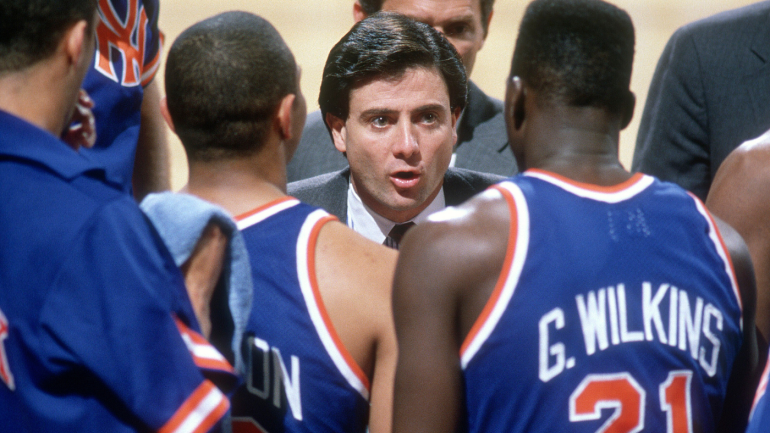Pitino was appointed the new coach of St. John’s on Monday.
A bit of a coaching chameleon, Rick Pitino. His generation of coaches were mostly characterized by protracted stays at a single school and unwavering loyalty to a single system. Jim Boeheim, who spent 47 years at Syracuse and almost exclusively used a 2-3 zone defense, was his last collegiate assistant coach. Pitino has served as the head coach of eight different organizations throughout the years, and while being recognized for using a full-court press, he has made several changes to his tactics. It was never more obvious than during his stint with the New York Knicks.
Pitino decided on Monday to take over the St. John’s Red Storm in his former stomping grounds of Madison Square Garden, a two-year period that has largely been forgotten by history. His new company would undoubtedly prefer that he stay in New York City for a longer period of time, but they’ll be lucky if his second visit to the city is even remotely as revolutionary as his first.
Let’s go back in time to 1988. By the standards of the Knicks at the time, Pitino’s 38-44 inaugural season in New York was actually a rather successful one. Despite having a burgeoning talent like Patrick Ewing, the Knicks had just 71 victories in their prior three seasons combined.
The remainder of the roster was the issue. The Knicks possessed Bernard King, a second star scorer, at the time Ewing was selected in the 1985 NBA Draft. King had just averaged a league-best 32.9 points per game for New York when he suffered one of the worst injuries in NBA history: a ruptured ACL that was accompanied by torn knee cartilage and a shattered leg bone. This happened late in the 1984–85 season. He never played the same way again, and even if he had, he would have only played in six more Knick games. As a result, the offense in New York with Ewing was understaffed. Throughout Ewing’s first three NBA seasons, the Knicks’ offense was never better than 20th out of 23 teams.
And the Knicks from 1988–1989? They had the sixth-best offense in the NBA and went 52-30. It’s not like roster upgrades were the cause of that improvement. While they added Charles Oakley to their starting lineup, his finest qualities were defense and rebounding. Their top four scorers were all on the squad the year before. Instead, Pitino identified a market inefficiency two decades before anyone else: the 1989 Knicks shot an unprecedented number of 3-pointers.
Even as a team, they weren’t particularly proficient at making 3-pointers. Only 33.7% of their attempts were successful. Just enough of them were taken that the relative amount overcame the opposition. In each game in 1988–89, the Knicks attempted 14 3-pointers. In terms of today, not a much, right? The Sacramento Kings, who are ranked No. 2, only took 10 per game. In 1989, only 7.4% of shots were 3-pointers for the average squad. The Knicks outperformed 15%. In order to match the relative advantage the Knicks possessed over the field, the modern version of the 1989 Knicks would need to shoot 3-pointers in nearly 79% of their field goal attempts.
Even before anyone knew it existed, they were dominating the arithmetic game. According to reserve Kiki Vandeweghe, “everyone has the go-ahead,” according to a 2020 New York Post article.
That’s not entirely accurate. Even though they were known as “The Bomb Squad” at the time, Trent Tucker (3.7 tries per game), Johnny Newman (3.5), Mark Jackson (3.3), and Gerald Wilkins were the four players that made the majority of their efforts (2.1). Only Wilkins among the four has ever attempted more shots per game at any stage in his career. Even Jackson, who played point guard for the NBA for another twelve years and later became the coach of Klay Thompson and Stephen Curry, was unable to match his 1989 statistics.
That is how ground-breaking Pitino’s strategy was at the time. Even his own teammates were unaware of the scope of what the club was accomplishing. After the season, Pitino moved for Kentucky, and the Knicks promptly declined to 45 victories, a No. 13 offense ranking, and just 8.7 3-point attempts per game in 1990. It wouldn’t be until 1995—when the NBA reduced the 3-point line and encouraged such shots—that they would achieve the 14 per game that Pitino’s club attempted.
This is particularly noteworthy because the Knicks under Pat Riley never had an offensive ranking higher than 12th (and were typically far lower). But, it’s very plausible that his dislike of 3-pointers at the time prevented the Knicks from scoring enough points to defeat Michael Jordan’s Bulls. He made up for their scoring inadequacies with defense and ferocity. Riley was given an offensive game plan by Pitino, which he mainly ignored, and the rest is history.
Pitino would subsequently miss the boat on the revolution that he had sparked, which is the irony of it all. Early in his tenure, he emphasized the 3-point shot, but as time went on, his Louisville teams’ offenses grew more and more out of date. In terms of 3-point attempts made per game, his first Cardinals squad was 12th in the NCAA. His previous one came in 232nd.
It remains to be seen where Pitino’s St. John’s team finishes, but he is not a one-trick pony. After all, he finished 208th in 3-point attempts in 2013 and won a title. Pitino won’t be known for a specific group of players or approach. His openness to try new things is his finest quality as a coach. When he last led a New York club, it served him well, and hopefully for St. John’s, it will now as well.
